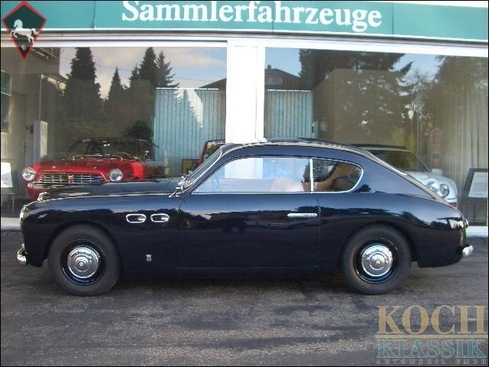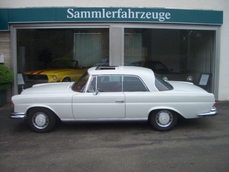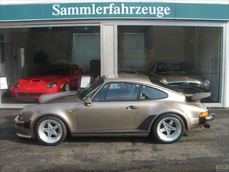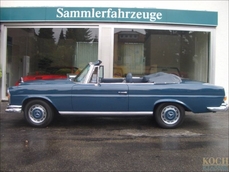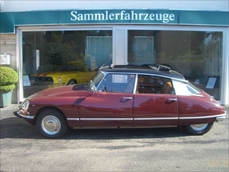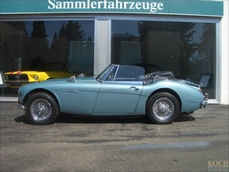Siata 208s Daina - Gran Sport Coupé 1952
General description :
Dieser Oldtimer wurde 2004 direkt aus USA zu uns geliefert. Es war in einem bedauernswerten Zustand und nicht komplett. Der Kunde legte Wert auf ein reise- und langstreckentaugliches Fahrzeug mit einer perfekten Ausstrahlung und nach seinen Wünschen optimiert. So entschied er sich gegen den original vorhandenen Motor (65 PS) und das 4 Gang Getriebe (ist natürlich im Lieferumfang enthalten) und ließ einen moderneren, nagelneuen FIAT Motor mit 1995 ccm Hubraum einbauen. Mit klassischen Tuning (2 Weber Doppelvergaser usw.)stieg die Leistung nun auf ca.130 PS und die Leistung wird nun über ein 5 Gang Getriebe an die Hinterachse weitergeleitet. Da der Wagen jetzt bequem und schnell auch größere Strecken zurücklegen kann wurde die Bremsanlage durch besondere Bremsbeläge usw. optimiert und angepasst. Die Karosserie wurde komplett restauriert und fehlende Teile angefertigt. Natürlich wurde die komplette Technik überholt bzw. erneuert, genauso wie die Innenausstattung. Dass das technisch nicht so einfach ging, will ich hier nicht im Detail erklären aber wir konnten sämtliche Kundenwünsche inkl. Eberspächer Standheizung und Edelstahl Auspuffanlage inkl. Krümmer erfüllen. Den Wunsch nach einer Lackierung mit extremem Tiefenglanz konnten wir erreichen, indem wir den dafür vorbereiteten Wagen nach dem Lackieren mit extrem feinkörnigem Schleifpapier von 2 Mitarbeitern 1 Woche lang abschleifen und dann hochglanzpolieren ließen, mit einem sensationellen Ergebnis das man einfach selbst gesehen haben sollte. Als wir nach 5 Jahren! fertig waren, bestätigte uns der Gutachter 2009 eine Zustandsnote 1 und einen Marktwert von 170.000, -- €, was uns dann doch auch stolz auf unsere Arbeit machte. Zwischenzeitlich hat der Wagen 1338 km zurückgelegt und sucht aus Zeitmangel seines Besitzers einen Liebhaber, der die Exklusivität und Qualität dieses Exoten zu würdigen weis und keine 5 Jahre warten möchte. Im KundenauftragBenzin 5-Gang Getriebe restauriert SportauspuffSportfahrwerk Standheizung Leder Modifizierter Motor GetuntWertgutachten
1952 Siata 208s Daina - Gran Sport Coupé is listed for sale on ClassicDigest in Heilbronn by Koch Klassik Automobil GmbH for €165000.
Car Facts
Car type : Car Make : Siata Model : 208s Model Version : Daina - Gran Sport Coupé Engine size : 0.0 Model Year : 1952 Sub type : Coupé Location : Schloss Strasse 2-4DE-74078 Heilbronn Vehicle Registration : Undefined
165000 €
Seller Information
Koch Klassik Automobil GmbH
Koch Klassik Automobil GmbH
+49 (0)7066 929995818
Koch Klassik Automobil GmbH
+49 (0)7066 929995818
Other cars listed for sale by this dealer
About Siata
Siata, an Italian automobile manufacturer, gained recognition for its production of small, high-performance sports cars primarily during the 1950s and 1960s. The company's name stands for "Società Italiana Auto Trasformazioni Accessori" (Italian Company for Automobile Transformations and Accessories), reflecting its early focus on car modifications and accessories.Narrative History of Siata:
Foundation: Siata was founded in Turin, Italy, in 1926 by Giorgio Ambrosini. Initially, the company specialized in tuning and modifying Fiat cars to improve their performance and appearance.
Early Years: Siata gained attention for its racing successes with modified Fiats, which helped establish its reputation as a performance-focused brand.
Post-WWII Expansion: After World War II, Siata started producing its own cars. They were often based on Fiat mechanicals but featured modified engines and unique bodywork, catering to enthusiasts looking for enhanced performance.
Siata Models and Technical Specifications:
Siata Amica:
Amica 600 (1948-1952): This was one of Siata's earliest models, based on the Fiat 600. It featured a modified engine and other performance enhancements.
Siata Spring:
Spring (1967-1970): This was a small convertible powered by a Fiat engine. It was designed for everyday use rather than high performance.
Siata 208/300BC:
Siata 208 (1953-1955): The Siata 208 was a sporty coupe powered by a 2.0-liter V8 engine, delivering impressive performance for its size.
Siata 208S:
Siata 208S (1953-1955): This model was an open-top sports car powered by the same 2.0-liter V8 engine as the 208. It was designed for enthusiasts seeking high performance and elegant styling.
Siata Daina:
Daina (1950-1958): The Daina was a series of grand tourers available in various body styles (coupe, convertible, etc.) and powered by a range of engines, including 1.5 to 2.0-liter options.
Siata 300 BC Spyder:
Siata 300 BC (1953-1958): This was a race-focused, lightweight sports car equipped with a potent 3.0-liter V8 engine, showcasing Siata's commitment to high-performance automobiles.
Siata Coupe and Roadster:
Siata Coupe and Roadster (1952-1954): These models featured different body styles powered by smaller displacement engines, offering a blend of performance and style.
Legacy:
Siata's cars were known for their combination of performance, style, and exclusivity. While the company ceased car production in the late 1960s, its impact on automotive history remains significant, especially among collectors and enthusiasts who appreciate Siata's hand-built sports cars' craftsmanship and performance-oriented approach.
